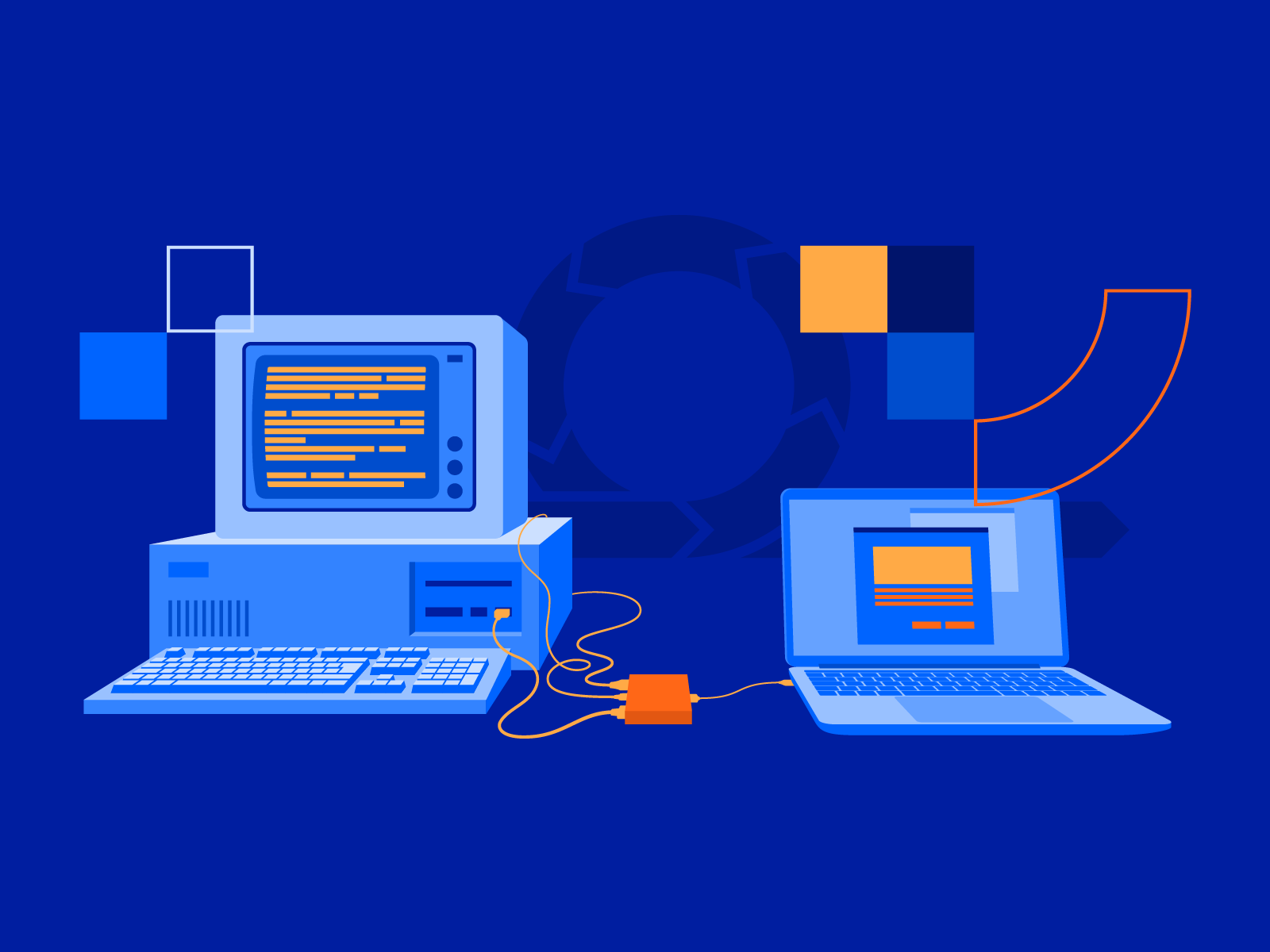What is the migration process of legacy systems?

"What is the migration process of legacy systems?" is a question that comes up amid the advancement of technology. This query sums up the challenge faced by companies that have their roots in outdated technological frameworks. In this article, we deconstruct this journey of change, highlighting the obstacles and strategies that must be used to guarantee a seamless transition.
A legacy system: what is it?
Outdated software programs that are still in use in organizations are known as legacy systems. Although these apps were once widely used, the introduction of new technologies and a lack of updated support have made them difficult to maintain and no longer meet the needs of the organization. It can take a lot of time and money to maintain and upgrade legacy systems, and it can be challenging to integrate them with more contemporary ones.
What is the migration process of legacy systems: obstacles need to be overcome
The migration from an antiquated system to a more contemporary one will be expensive and time-consuming. Careful planning and a comprehensive migration plan are necessary for the migration project. It must take into account the data migration procedure, the new system's capabilities and features, and the capabilities and features of the current system. When it comes to the migration of legacy systems, timing is crucial. It might take some time to complete the migration process, particularly if the system contains intricate processes. Budget is an important thing to consider because moving a legacy system requires hiring experts and buying new hardware and software.
Undoubtedly, one of the most challenging parts of the migration project is the data migration process. To guarantee that the new system is configured correctly and that any historical data is migrated correctly, accurate and clean data is necessary. A multiformat or multisystem storage of the information could make this process more complicated.
Lastly, an organization needs to think about the risk involved in the project of migration. To recognize, evaluate, and control the risks involved in transferring a legacy system, it is critical to have a strong risk management strategy.
Why Would a Business like to Migrate from a Legacy System?
Improved effectiveness and efficiency
Although they were popular, legacy systems now find it difficult to meet the increasing demands of contemporary businesses. Businesses can take advantage of the newest trends and technologies by upgrading to more sophisticated and modern software. Employee productivity will increase as a result of increased efficiency, which will free them up to concentrate on tasks with more value.
Lowering of costs
Businesses can incur significant costs when using outdated systems. The need for specialized support, high maintenance and licensing costs, and other expenses can quickly deplete funds. Furthermore, because they frequently use antiquated technologies, legacy systems are susceptible to expensive hardware malfunctions.
Switching to a new system can result in significant cost savings. Modern systems are made to be more economical, with customizable pricing schemes, cutting-edge cloud-based services, and less maintenance requirements. Businesses that adopt modern systems can also take advantage of far more efficient infrastructure, which eventually results in lower operating costs.
Enhanced scalability and integration
Because of their notoriously poor integration capabilities, legacy systems are difficult to connect and interact with other applications or systems. By moving to a more modern system, businesses can benefit from enhanced integration features that facilitate smooth data transfer and platform and software interoperability.
This improved integration lays the groundwork for future scalability while also increasing overall efficiency. Businesses are free from the limitations of legacy software to grow, expand, and adjust to changing business needs thanks to the ease with which new tools and applications can be integrated.
Improved compliance and security
Often, outdated platforms don't have the strong security measures needed to successfully fend off contemporary cyberattacks. They are also infamous for having poor compliance capabilities, which makes it difficult to follow industry guidelines and obtain necessary certifications. Upgrading to new software can offer improved security features, such as multi-factor authentication, proactive monitoring, and advanced encryption, as well as increase compliance.
Support and availability of vendors
Vendors may stop supporting older products as time goes on or redirect their attention to newer models, leaving businesses on their own when problems emerge. Furthermore, it can be challenging to find new, qualified personnel to support legacy software since it frequently uses antiquated technologies and programming languages like Cobol.
Making the switch to a more contemporary system gives you access to a wider range of IT specialists and vendors that are knowledgeable about the technologies you require. These experts can offer prompt assistance and access to the most recent updates, patches, and bug fixes you need to keep your software operating smoothly thanks to their up-to-date knowledge and skills.
Innovation and competitive advantage
With its cutting-edge features and functionalities, modern software empowers businesses with automation, artificial intelligence, and machine learning. These innovations will transform your company's operations, enhance user experience, and open up new revenue streams. You'll stay on top of trends, draw in new clients, and outperform competitors in your field as a consequence.
Method for Migration of Legacy Systems
What does it mean to effectively transition to a new system? Most of the time, it will involve modern hardware or software that operates efficiently. The crucial issue is figuring out how to gradually replace the outdated system with the new one, piece by piece. It is at this point that a plan for migrating legacy systems must be established.
A legacy system migration checklist is provided here to make sure everything is done properly:
- Decide which data you want to transfer to the new system. Make sure you know exactly what data needs to be moved and in what format once it has been migrated. If you are moving sensitive data, make sure you have checked all security precautions.
- Establish your financial, technical, and time requirements for the migration. It's crucial to define everything at the outset of the process. For example, you might discover that the system migration will take too much time. This implies that, in the interim, other tools should be used to manage the entire business operation. Prioritize estimating the technical requirements and budget because it might be challenging to make changes while working with different hardware.
- Create a data backup. It offers excellent protection against potential data loss. You will have all the data needed for recovery in the event that the migration fails.
- Plan your system migration. It ought to be simple to handle and easy to follow.
- Give the new system a test. After every stage of the system migration, you can test the system to make sure everything functions as it should.
- Do routine system maintenance. Continuous testing is another essential step toward effective system performance. Make sure you can continue to perform system checks even after the system has been relocated.
What is the migration process of legacy systems: A step-by-step guide
The following actions should be taken into account after creating a migration plan if you want to start an efficient strategy for replacing outdated systems.
Make sure that the system migration is known to all parties involved. All business divisions will be impacted by migration, so garnering support from all organization stakeholders is crucial. Tell them why the company must switch over to the new system and make sure each department sends in its own requirements.
Examine each business process in its entirety. You must be knowledgeable about every business process within the company before deciding which approach to use or how to carry out the migration. To make sure that everything will be handled correctly by the new system, a thorough analysis may be essential.
Establish important checkpoints and project schedules. Having a timeline for each system migration milestone will make the process run more smoothly. It will highlight who is responsible for what during the entire migration process.
Select the ideal technology for your company's requirements. Determine what obstacles each technology can present and how it will help the new system by researching what has proven to be most effective for similar types of businesses. The most effective way to move all the data is to use technology to create new systems.
Make sure the new system is constantly being observed. You still need to make sure that the newly installed system operates properly after the migration is complete. Performance metrics like conformance, rework, and the interval between process steps are among the ones you can use. Comparing a new system with a legacy one will be helpful.
Final reflections
The migration process of legacy systems becomes an essential task for companies navigating the ever-changing landscape of technology. The knowledge and experience that Axalize has in this area is extremely valuable, enabling companies to confidently and precisely traverse the challenges of modernization. Through utilizing Axalize's service with resources and comprehending the nuances, obstacles, and optimal methodologies delineated in this piece, organizations can commence their migration expedition outfitted to effectuate a smooth system transformation. In the digital age, businesses can open up new growth and innovation opportunities by implementing strategic planning.
>> Maybe you’re also interested in Legacy modernization challenges and the best solutions for 2024


